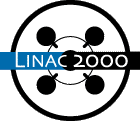
P.D. SMITH (General Atomics)
The CCT (Coupled Cavity Tuning) code, written in support of the APT Project, automates the RF calculations and sizing of coupled RF cavities. CCT controls the CCLFISH code, a member of the Superfish [1] series, while CCLFISH performs RF calculations and tunes the geometry for individual cavities, including an accelerating cavity (AC) and a coupling cavity (CC). CCT relates the AC and CC by means of equations that describe the coupling slot between the two cavities. These equations account for the direct coupling, the next nearest neighbor coupling between two adjacent AC's, and the frequency shifts in the AC and CC caused by the slot. Given design objectives of a coupling coefficient, the pi/2 mode frequency of the AC, and the net frequency of the CC, the code iterates to a consistent solution for the AC geometry, the CC geometry, and the separation distance between the AC and CC (this controls the slot size) that satisfies the specified design conditions. The resulting geometry is used to automate CAD drawing preparation. The code can also be used in 'as-built' mode to calculate the frequencies and coupling of a specified configuration. An overview of the code and its applications will be presented.
[1] J. H. Billen and L. M. Young, 'POISSON SUPERFISH,' Los Alamos National Laboratory report LA-UR-96-1834 (revision March 14, 2000).
* Work supported by U.S. DOE contract DE-AC04-96AL89607
Comments or Questions to
linac2000@slac.stanford.edu